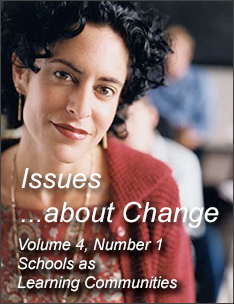Regeneration: The Principal Factor
As noted, four principals contributed to the Dibert Difference, as it came to be known. They were Lucianne Carmichael, Clif St. Germain, Nancy Picard, and Wiley Ates.
Lucy's Legacy
Lucianne Carmichael favored a child-centered approach, and she suggested this idea to the parents who came seeking her advice. The changes at Dibert began with her idea that "a true child-centered approach is really a person-centered approach . . . because teachers can't honor children until they have been honored themselves." One part of this person-centered approach was giving staff the option of transferring to another school if they did not want to be part of the new program. Any new staff who came to the school to replace those who chose to leave were to be selected by Lucianne. This was quite unusual in 1975. In fact, Lucianne reports, "I'm sure I was the first principal that ever interviewed teachers [in the district]. It was a battle to achieve that, but [the district] agreed."
Originally, Lucianne lobbied for a summer-long training program for the teachers, but money was available for only one week. With some new materials and one week of training, they began to re-create the school. They ungraded classrooms and grouped children of several ages in family groupings. Carmichael articulated the philosophy underlying this arrangement. "Children learn by copying other children more than from any other source. We know that from raising our own children. . . . In schools we don't use that because we think that children are going to learn (a) out of the book and (b) from the teacher. They learn from other kids and by doing it themselves."
Another part of Lucianne's philosophy was expressed in the continuous opportunities provided to children to develop and demonstrate artistic creativity. Whether through music, drama, dance, or the visual arts, children could share themselves and their richly divergent culture and backgrounds. In this way, children were honored for their special differences that collectively contributed to Dibert, their "rainbow school." This was congruent with Lucianne's own experiences as an artist - a potter.
"Until thinking changes, nothing will change," Lucianne observed. "I spent a long, long time with teachers. My total investment of time or money or anything was always in the staff. Before I would buy any kind of equipment or spend money on the building, the money would first be spent on opportunities for the teachers or time for teachers, for all of us. I learned from the beginning that the most important resource that we had was the staff. No amount of money was too much to invest in them."
Lucianne took several teachers to visit schools in England that were using the child-centered approach. "It's just like any kind of learning. To read about it falls short; if you go and experience something you can really know what it is we are talking about. I always felt for myself and the other teachers that we had to get into other schools. We had to really go and see and experience and do. . . . So every penny that I could get for teachers or me to travel, we did."
"We have to feed ourselves, invest in ourselves, teach ourselves; we have to be the first learners. Unless the teachers are the primary learners in that building, the children don't learn much. Teachers have to have time to do that; they have to have support."
Time, thus, was another resource Lucianne provided for the staff and their development. Because the district did not provide any more paid time, the staff began to rethink the time that they already had available. They realized that time was "a very malleable resource." The staff decided to reallocate time by teaching longer on four days of the week and dismissing the children early on Thursdays. The time gained on that day was used for teachers to meet together, but never for "regular" faculty meetings. "The underlying idea was always it was for some kind of self-development process." Thus Faculty Study began on Thursdays. To that end, the teachers "were bombarded from the first, surrounded as much as possible with good reading, with good materials that we worked on together."
Through extensive interaction with teachers, Lucianne nurtured a shared vision. "I continuously wrote notes and letters to teachers. I went in classrooms; I would come out and write notes supporting every positive thing that I saw. . . . In my job as principal, the teachers were my students in a sense, and I had to do with them everything that I wanted them to do with the students. I had to trust them, and honor them, and support them, and inspire them, and nurture them, and reinforce the good things that I saw them doing. When they began to experience that, I think they began to have more vision and ability to have things like that happening in their classroom. . . . When that starts in the teacher's mind, it doesn't end. It snowballs."
The entire school community - administrators, teachers, children, parents who dropped in - also met together daily at Morning Meeting. Each day in the school's basement, they shared school and classroom events, and honored children's accomplishments. A sense of family was strengthened through this daily interaction.
Next Page: The Second Principal, Clif: Passing the Potter's Torch

